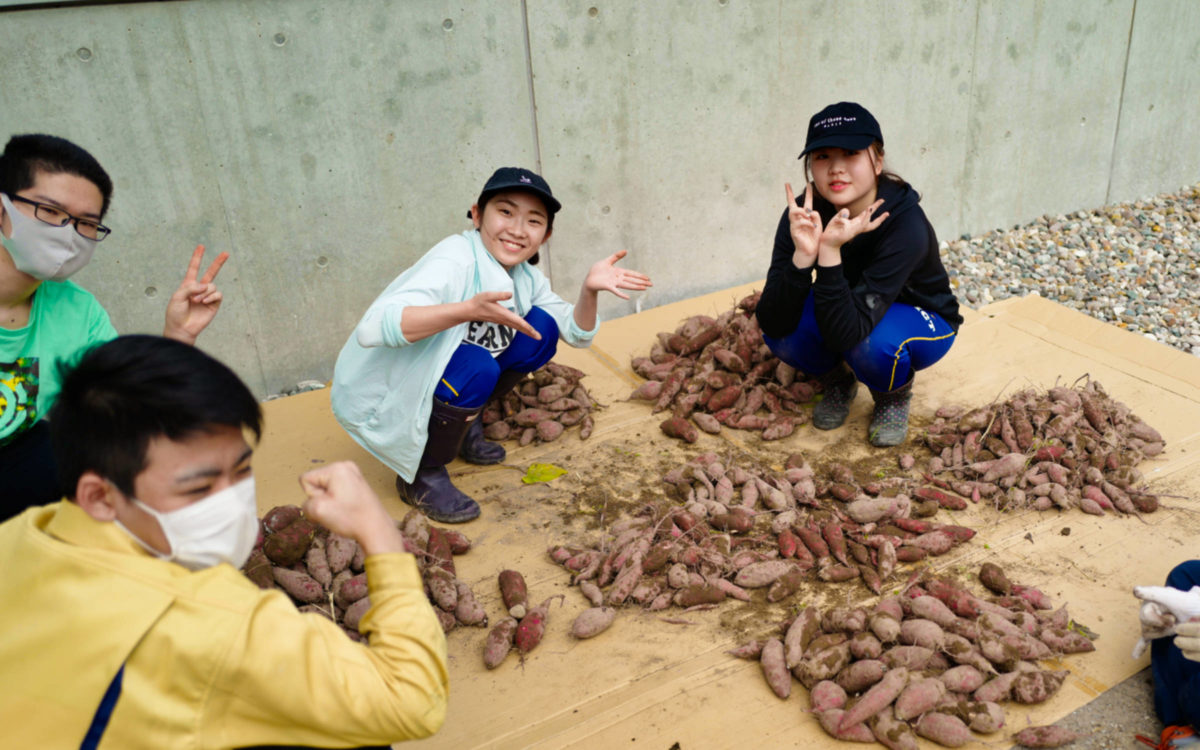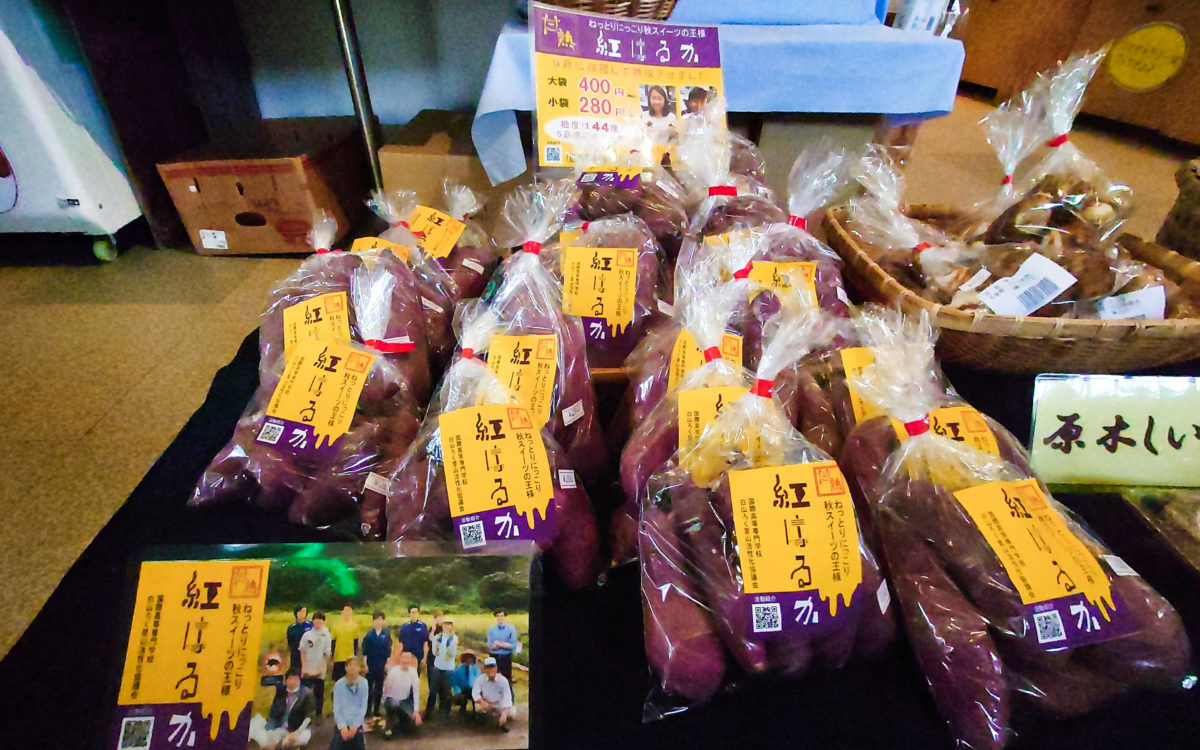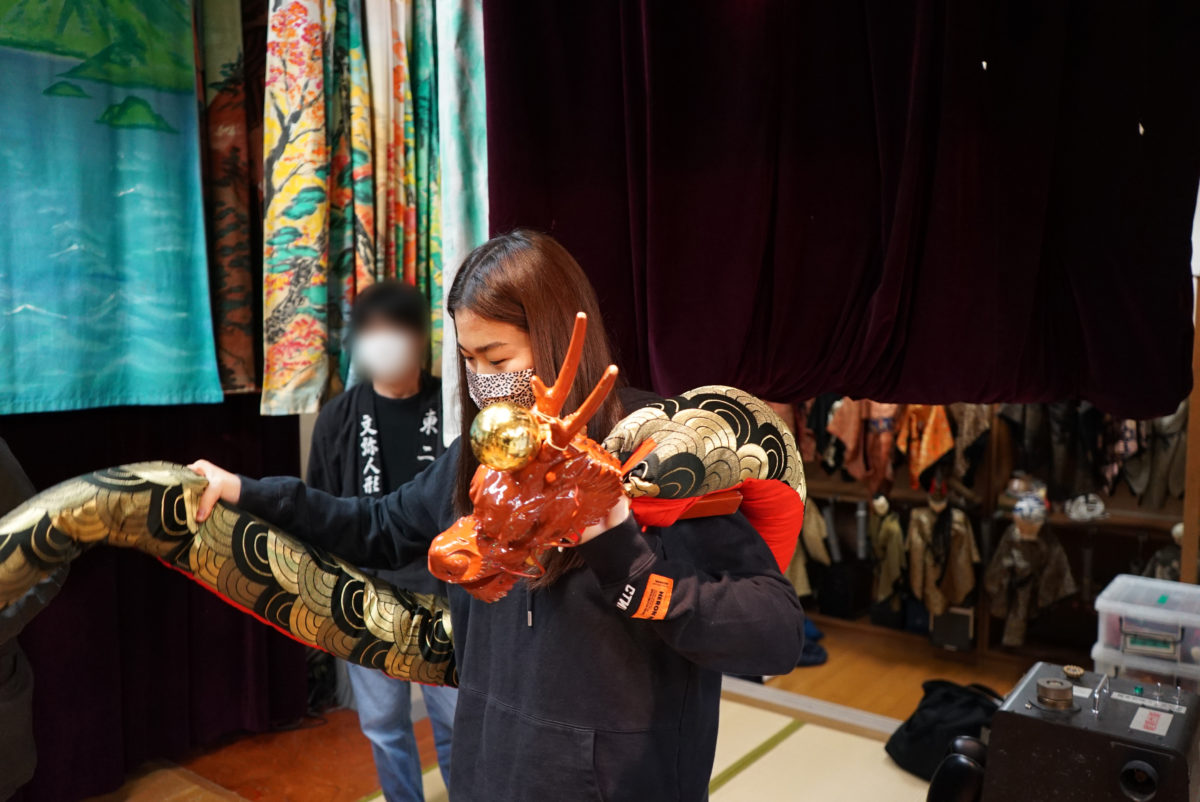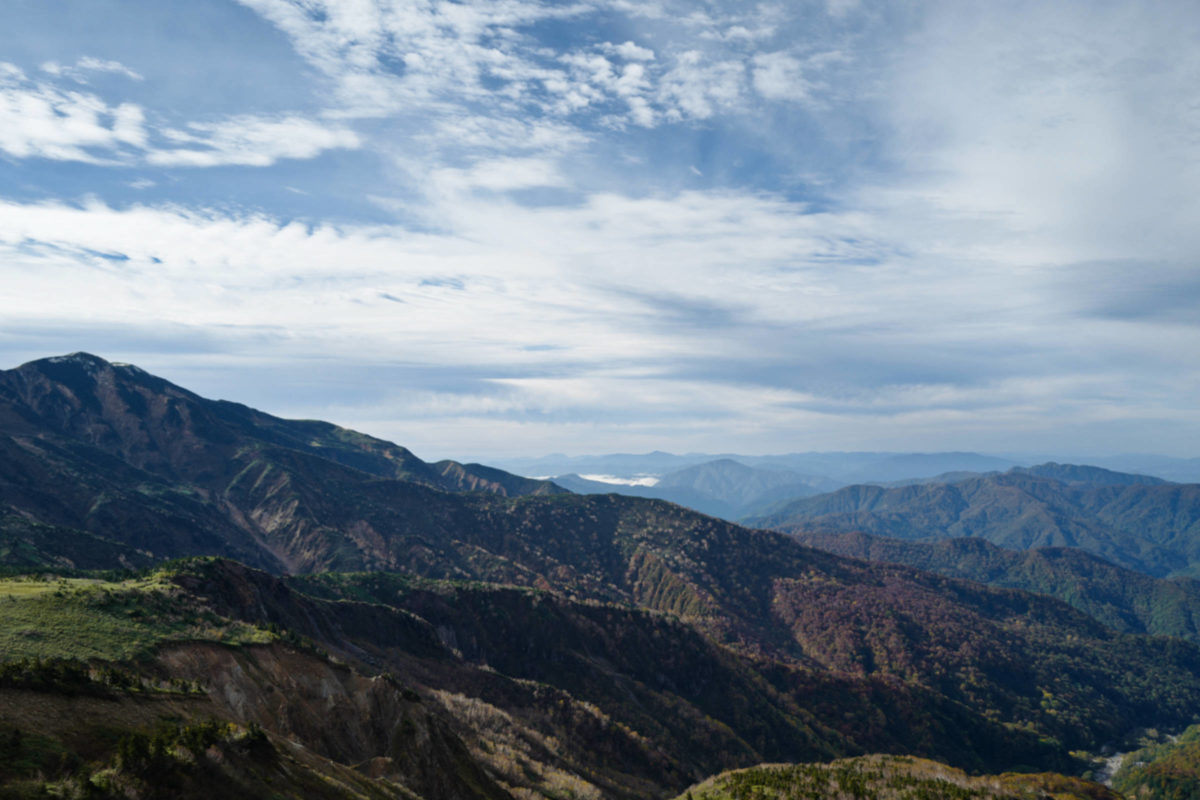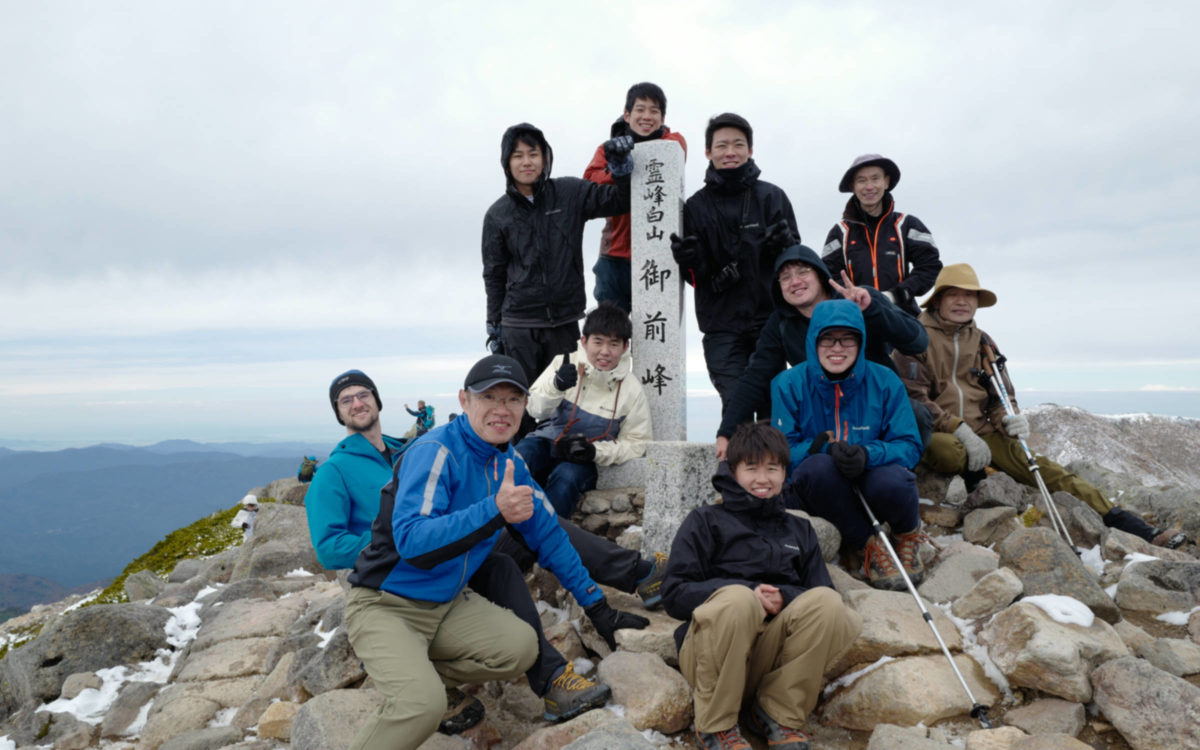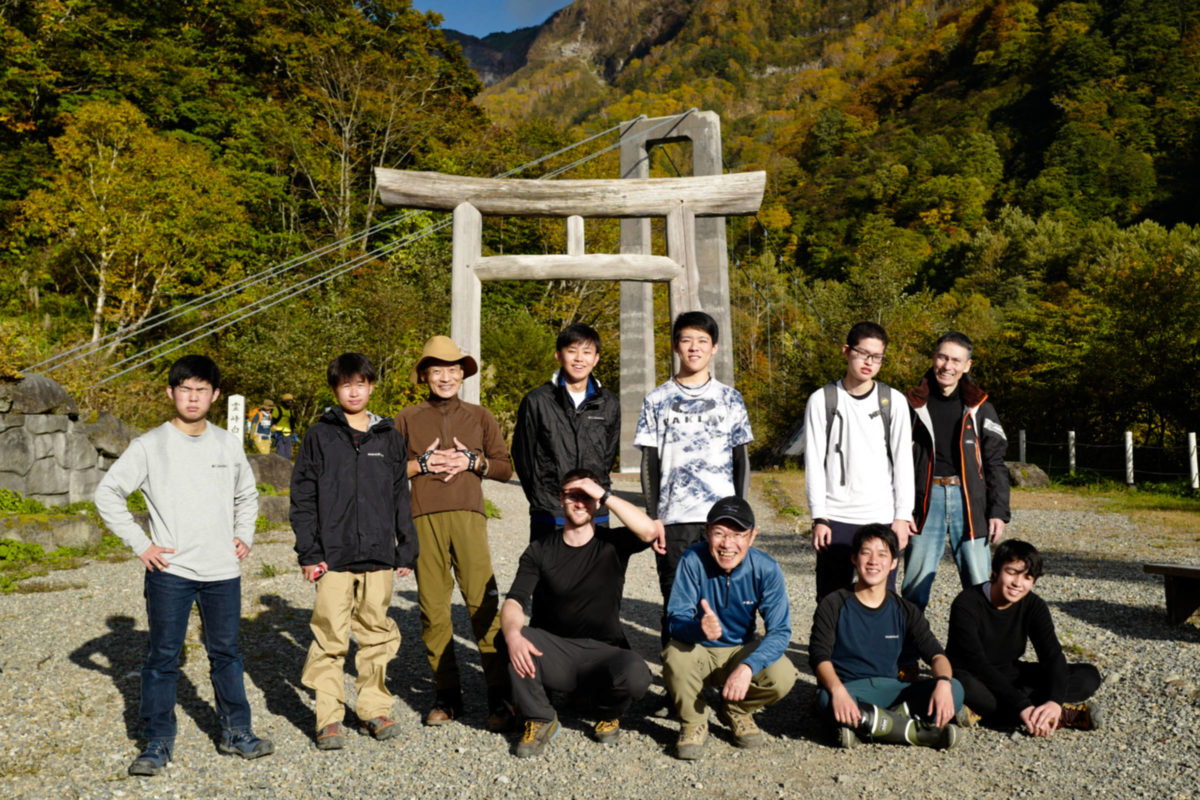Local Community
地域連携

2021年2月6日(土)、白山麓キャンパスの特別活動としてスノーハイキングを行いました。このイベントはNature and Adventure Clubの尾張コーチの企画運営によるものです。参加者はアファフさん、本田さん、勝方さん、酒井さん、中里さん(全員1年生)、尾張コーチ、潟辺先生、フィリップ先生、ナグワ先生と私です。朝9時に白山麓キャンパスを出発し、20分ほどのところにある岩間林道入り口に車を駐車しました。そこからカンジキを履いてハイキングを開始しました。途中、尾張コーチによるカンジキ歩行や動物の足跡観察のレクチャーが行われました。見晴らしの良い尾根に出たところで休憩、春の兆しを感じる日光浴をしながら、気持ちの良いひと時を過ごしました。11時過ぎに目的地であるブナオ山観察舎に到着し、双眼鏡を覗いたりイヌワシなどの剥製を観察しました。今シーズン初めて実施したスノーハイクは、全員が安心して楽しむことができたため、来年度以降Nature and Adventure Clubの定例イベントにしていこうと思います。
On February 6 (Sat) 2021, a group of students and teachers went snow hiking near Hakusanroku Campus. This event was organized by Owari coach of the Nature & Adventure Club. Participants were Afaf, Honda, Katsukata, Sakei, Nakazato (all first-year students), Owari coach, Katabe sensei, Philip sensei, Nagwa sensei, and myself. We departed from ICT at 9 am and parked near the entrance to Iwama Rindo, which is about a 20 minute drive from Hakusanroku Campus. We put on our snow shoes and began hiking. On the way, Owari coach gave advice about how to walk with snow shoes and how to observe various animal tracks. There was a nice ridge with a beautiful view and we stopped to take a group photo and enjoy the warm sun. It was a our first glimmer of spring. We arrived at our destination, the Binao Mountain Observatory, and spent time looking through the binoculars and observing the stuffed animals on display such as the golden eagle. I'm glad students were able to safely enjoy this year's first snow hike. Hopefully it can be an event we do every year.

山崎俊太郎
Shuntaro Yamazaki
写真提供:酒井遼(1年)Photos by Ryo Sakei (first year)

2021年2月6日(土)、白山麓キャンパスの特別活動としてスノーハイキングを行いました。このイベントはNature and Adventure Clubの尾張コーチの企画運営によるものです。参加者はアファフさん、本田さん、勝方さん、酒井さん、中里さん(全員1年生)、尾張コーチ、潟辺先生、フィリップ先生、ナグワ先生と私です。朝9時に白山麓キャンパスを出発し、20分ほどのところにある岩間林道入り口に車を駐車しました。そこからカンジキを履いてハイキングを開始しました。途中、尾張コーチによるカンジキ歩行や動物の足跡観察のレクチャーが行われました。見晴らしの良い尾根に出たところで休憩、春の兆しを感じる日光浴をしながら、気持ちの良いひと時を過ごしました。11時過ぎに目的地であるブナオ山観察舎に到着し、双眼鏡を覗いたりイヌワシなどの剥製を観察しました。今シーズン初めて実施したスノーハイクは、全員が安心して楽しむことができたため、来年度以降Nature and Adventure Clubの定例イベントにしていこうと思います。
On February 6 (Sat) 2021, a group of students and teachers went snow hiking near Hakusanroku Campus. This event was organized by Owari coach of the Nature & Adventure Club. Participants were Afaf, Honda, Katsukata, Sakei, Nakazato (all first-year students), Owari coach, Katabe sensei, Philip sensei, Nagwa sensei, and myself. We departed from ICT at 9 am and parked near the entrance to Iwama Rindo, which is about a 20 minute drive from Hakusanroku Campus. We put on our snow shoes and began hiking. On the way, Owari coach gave advice about how to walk with snow shoes and how to observe various animal tracks. There was a nice ridge with a beautiful view and we stopped to take a group photo and enjoy the warm sun. It was a our first glimmer of spring. We arrived at our destination, the Binao Mountain Observatory, and spent time looking through the binoculars and observing the stuffed animals on display such as the golden eagle. I'm glad students were able to safely enjoy this year's first snow hike. Hopefully it can be an event we do every year.

山崎俊太郎
Shuntaro Yamazaki
写真提供:酒井遼(1年)Photos by Ryo Sakei (first year)
 We are approaching the end of our third year of ICT’s new curriculum and new campus. There are many things I love about living and working in Hakusanroku. One of them is the history and culture of this area. I always like to find out about the places I live, and I’ve been trying to do that here by getting involved in the community. I hold monthly English Café events at the local Community Centre, and I made an English translation of the exhibitions at the Hakusan Folk Museum in Shiramine.
We are approaching the end of our third year of ICT’s new curriculum and new campus. There are many things I love about living and working in Hakusanroku. One of them is the history and culture of this area. I always like to find out about the places I live, and I’ve been trying to do that here by getting involved in the community. I hold monthly English Café events at the local Community Centre, and I made an English translation of the exhibitions at the Hakusan Folk Museum in Shiramine.
Another way of learning about the history and culture of Hakusanroku is through our school’s library, which has some old books about the local area. When browsing one day I pulled a fascinating bilingual book off the shelf: ‘Villages of Tedori River Gorge: The final curtain descends on a way of life, its traditions, and ancient culture’ by Morton W. Huber.
It turns out that Morton Huber was a Professor of Environmental Science at KIT in the 1970s and in his spare time used to travel up to Hakusanroku to paint, draw, and take photographs. This book was published in 1976 and in it Dr. Huber writes about the way of life and culture of people in Hakusanroku, including ningyou jyoruri puppet shows from Higashi-futakuchi and Fukaze, hinoki crafts from Fukaze, and silkworm raising and tree growing in Kuwajima. He also writes at length about the Tedori Dam that was due to be built and many of these villages, and their culture, were due to be lost. As a result, the book has an underlying nostalgia and sadness, along with Dr. Huber’s beautiful photographs and sketches, which evoke a rural way of life that has mostly been lost, but glimpses of which can still occasionally be seen.
I searched for Dr. Huber online and found that he is still alive – aged 97! I think it would be very interesting if his old employer, KIT, got in touch to tell him about the new campus they built in a part of the world that he loved so much.
James Taylor (English Department)
いよいよ国際高専の新しいカリキュラムの3年目が終わります。白山麓に住んで働くといろんないいことがあります。その中の一つはこの地域の歴史と文化です。僕はいつも住んでいる場所のことを詳しく知りたいですから、ここにもコミュニティでいろんな活動をしています。月に1回尾口公民館で「イングリッシュカフェ」というイベントをやったり、白峰にある白山ろく民族資料館に展示してる日本語を英語版を翻訳しました。
そして、国際高専の図書館は白山麓の歴史や文化についての古い本がたくさんあります。ある日、僕はとても面白いバイリンガルな本を1冊見つけました。それは、モートン・ヒューバー先生の「手取峡谷の村落 終幕の下りるとき」という本です。
モートン・ヒューバー先生は1970年代に金沢工業大学で環境工学の教授として働きました。その間に、スケッチや水彩画や白黒の鉛筆画や写真の作品を作るためによく白山麓まで来ました。この1976年に出版された本にモートン・ヒューバー先生は白山麓の歴史と文化を説明します。特に東二口と深瀬の人形浄瑠璃、深瀬のヒノキ笠、桑島の養蚕と山林の木の育ちが注目されています。その時代は手取りダムを作ることが決めたけど、工事はまだ始まってない時でしたから、この本はなくなる文化や生活振りのノスタルジーと残念な気持ちで書いてあると思います。モートン・ヒューバー先生の絵は今の時代にあまり見えない田舎の生活を見せる絵です。でも、現在の白山麓では昔の生活振りが残っているところが時々見えます。
モートン・ヒューバー先生をインターネットで調べたら、まだ97歳で元気にアメリカで暮らしているそうです。モートン・ヒューバー先生が昔働いた大学から「大好きな白山麓に新しいキャンパスが建てました」の連絡があったら面白いと思います。
ジェームス・テイラー(英語科)
 We are approaching the end of our third year of ICT’s new curriculum and new campus. There are many things I love about living and working in Hakusanroku. One of them is the history and culture of this area. I always like to find out about the places I live, and I’ve been trying to do that here by getting involved in the community. I hold monthly English Café events at the local Community Centre, and I made an English translation of the exhibitions at the Hakusan Folk Museum in Shiramine.
We are approaching the end of our third year of ICT’s new curriculum and new campus. There are many things I love about living and working in Hakusanroku. One of them is the history and culture of this area. I always like to find out about the places I live, and I’ve been trying to do that here by getting involved in the community. I hold monthly English Café events at the local Community Centre, and I made an English translation of the exhibitions at the Hakusan Folk Museum in Shiramine.
Another way of learning about the history and culture of Hakusanroku is through our school’s library, which has some old books about the local area. When browsing one day I pulled a fascinating bilingual book off the shelf: ‘Villages of Tedori River Gorge: The final curtain descends on a way of life, its traditions, and ancient culture’ by Morton W. Huber.
It turns out that Morton Huber was a Professor of Environmental Science at KIT in the 1970s and in his spare time used to travel up to Hakusanroku to paint, draw, and take photographs. This book was published in 1976 and in it Dr. Huber writes about the way of life and culture of people in Hakusanroku, including ningyou jyoruri puppet shows from Higashi-futakuchi and Fukaze, hinoki crafts from Fukaze, and silkworm raising and tree growing in Kuwajima. He also writes at length about the Tedori Dam that was due to be built and many of these villages, and their culture, were due to be lost. As a result, the book has an underlying nostalgia and sadness, along with Dr. Huber’s beautiful photographs and sketches, which evoke a rural way of life that has mostly been lost, but glimpses of which can still occasionally be seen.
I searched for Dr. Huber online and found that he is still alive – aged 97! I think it would be very interesting if his old employer, KIT, got in touch to tell him about the new campus they built in a part of the world that he loved so much.
James Taylor (English Department)
いよいよ国際高専の新しいカリキュラムの3年目が終わります。白山麓に住んで働くといろんないいことがあります。その中の一つはこの地域の歴史と文化です。僕はいつも住んでいる場所のことを詳しく知りたいですから、ここにもコミュニティでいろんな活動をしています。月に1回尾口公民館で「イングリッシュカフェ」というイベントをやったり、白峰にある白山ろく民族資料館に展示してる日本語を英語版を翻訳しました。
そして、国際高専の図書館は白山麓の歴史や文化についての古い本がたくさんあります。ある日、僕はとても面白いバイリンガルな本を1冊見つけました。それは、モートン・ヒューバー先生の「手取峡谷の村落 終幕の下りるとき」という本です。
モートン・ヒューバー先生は1970年代に金沢工業大学で環境工学の教授として働きました。その間に、スケッチや水彩画や白黒の鉛筆画や写真の作品を作るためによく白山麓まで来ました。この1976年に出版された本にモートン・ヒューバー先生は白山麓の歴史と文化を説明します。特に東二口と深瀬の人形浄瑠璃、深瀬のヒノキ笠、桑島の養蚕と山林の木の育ちが注目されています。その時代は手取りダムを作ることが決めたけど、工事はまだ始まってない時でしたから、この本はなくなる文化や生活振りのノスタルジーと残念な気持ちで書いてあると思います。モートン・ヒューバー先生の絵は今の時代にあまり見えない田舎の生活を見せる絵です。でも、現在の白山麓では昔の生活振りが残っているところが時々見えます。
モートン・ヒューバー先生をインターネットで調べたら、まだ97歳で元気にアメリカで暮らしているそうです。モートン・ヒューバー先生が昔働いた大学から「大好きな白山麓に新しいキャンパスが建てました」の連絡があったら面白いと思います。
ジェームス・テイラー(英語科)
 カメラマンのジョナサンです!今日は2年生の「エンジニアリングデザイン」の活動を紹介します。
カメラマンのジョナサンです!今日は2年生の「エンジニアリングデザイン」の活動を紹介します。
国際高専の問題発見解決型の授業、「エンジニアリングデザイン」では、学生がユーザーの視点に立って課題を明確化、解決策のアイデアを考慮しプロトタイプを作っています。今年は2年生7名が白山麓キャンパス校舎前の休耕田に着目して、「アグリテック班」「アグリビジネス班」の2つのグループに分かれて課題解決に挑みました。
昨年、課外活動の一環で、一部の学生と先生が白山麓キャンパス前にある休耕田でさつまいもを栽培しましたが、サルにより収穫のほとんどを奪われてしまいました。金沢工業大学と連携して、大学の研究室で試作された獣害対策ロボットを試しましたが、風などで動きのある自然を背景にした場合、動物の認識率が低いことがわかりました。そこで「アグリテック班」はAIを使って自然の中でもサルを認識できるシステムの開発を行うことにしました。後学期はプログラム開発を進め、11月に入ってからは津幡町にある石川県森林公園で、ニホンザルの写真を7,000枚撮ってシステムに学習させて認識の精度を高めました。これらの活動は11月13日(金)にNHK金沢放送局の「かがのとイブニング」にも取り上げられました。農作物の被害は全国的な課題となっており、今後は畑にサルが侵入した際に、所有者のスマートフォンに知らせるシステムの構築を目標にしています。
「アグリビジネス班」の学生たちは地域活性化を図るために「愛・AIいもプロジェクト」を4月に発足し、休耕田にさつまいも「紅はるか」の植え付け、草むしり、収穫を自ら行いました。今年は電気柵を使ってサル対策をしたおかげで栽培した芋の9割以上を収穫できました。学生たちは糖度計を使って収穫した紅はるかの糖度を計測したところ44度という非常に高い数値を確認し、焼き芋にするとねっとりと甘く、大変美味しいことがわかりました。学生たちは芋を洗ってから大きさごとに分別し、オリジナルデザインのラベルを貼って販売用にパッケージングを行いました。白山麓発のブランド化を目指して「甘熟紅はるか」と名付けられたこれらのさつまいもは道の駅「瀬女」や地元のスーパーで販売したところ、すぐに在庫がなくなるほどの人気でした。
次年度以降は、「アグリテック班」が開発した獣害対策システムの完成度向上を計りながらブランドのさつまいもの生産販売を地域と協力しながら推進する予定です。
ジョナサン
Hi, its Jonathan the cameraman. Today, I will give a report on what some of the second year students have been doing in "Engineering Design" class.
ICT's "Engineering Design" is a course in which students find problems in their community or society by interviewing people and creating prototypes that solve them. Seven of this year's second year students decided to focus on the unused fields across the street from the Hakusanroku Campus and start the "Ai Ai Imo Project", which consists of two groups: "Agri-tech" and "Agri-business".
Last year, some students planted sweet potatoes in the same field as part of their club activity. Despite their hard efforts, most of the potatoes were dug up and eaten by monkeys. They partnered with Kanazawa Institute of Technology to test a wild animal defense robot. However, it proved unable to detect animals when set in a wild environment due to wind moving the plants in the background. Learning this, the "Agri-tech" group decided to create a system that detects monkeys in the wild using AI. The actual construction of the system started this semester. In November, they traveled to the national park in Tsubata-machi and took over 7,000 pictures of the monkeys there to increase the accuracy of the AI. These activities were even featured on national television "Kaga-noto Evening" on November 13. Damage to crops by wild animals is a serious problem in Japan and the group hopes to develop a system that can detect monkeys entering a field and notify the owner via their smartphone.
The "Agri-business" group started the "Ai Ai Imo Project" in April. Their goal was to utilize the unused field to grow and sell sweet potatoes. To not repeat the same mistake as last year, this year's second year students built an electric fence around the patch to shut out the monkeys. Thanks to this and some quick decisions, they were able to harvest over 90% of the sweet potatoes. Students measured the sugar content of the potatoes, which turned out to be a remarkably high 44 degrees. After roasting and eating the sweet potatoes, we confirmed that they were rich, sweet and delicious. The students rinsed and separated the sweet potatoes by size, which they then packaged and labeled. These sweet potatoes were branded "Kanjuku (sweet and ripe) beni-haruka" and were sold at the michi-no-eki "Sena" souvenir shop and local super market "Yorankaine". They were extremely popular and sold out in a couple of days.
Next year, we hope to improve the system created by the "Agri-tech" group and work with the local community to further promote the sweet potatoes to draw people to Hakusanroku.
 カメラマンのジョナサンです!今日は2年生の「エンジニアリングデザイン」の活動を紹介します。
カメラマンのジョナサンです!今日は2年生の「エンジニアリングデザイン」の活動を紹介します。
国際高専の問題発見解決型の授業、「エンジニアリングデザイン」では、学生がユーザーの視点に立って課題を明確化、解決策のアイデアを考慮しプロトタイプを作っています。今年は2年生7名が白山麓キャンパス校舎前の休耕田に着目して、「アグリテック班」「アグリビジネス班」の2つのグループに分かれて課題解決に挑みました。
昨年、課外活動の一環で、一部の学生と先生が白山麓キャンパス前にある休耕田でさつまいもを栽培しましたが、サルにより収穫のほとんどを奪われてしまいました。金沢工業大学と連携して、大学の研究室で試作された獣害対策ロボットを試しましたが、風などで動きのある自然を背景にした場合、動物の認識率が低いことがわかりました。そこで「アグリテック班」はAIを使って自然の中でもサルを認識できるシステムの開発を行うことにしました。後学期はプログラム開発を進め、11月に入ってからは津幡町にある石川県森林公園で、ニホンザルの写真を7,000枚撮ってシステムに学習させて認識の精度を高めました。これらの活動は11月13日(金)にNHK金沢放送局の「かがのとイブニング」にも取り上げられました。農作物の被害は全国的な課題となっており、今後は畑にサルが侵入した際に、所有者のスマートフォンに知らせるシステムの構築を目標にしています。
「アグリビジネス班」の学生たちは地域活性化を図るために「愛・AIいもプロジェクト」を4月に発足し、休耕田にさつまいも「紅はるか」の植え付け、草むしり、収穫を自ら行いました。今年は電気柵を使ってサル対策をしたおかげで栽培した芋の9割以上を収穫できました。学生たちは糖度計を使って収穫した紅はるかの糖度を計測したところ44度という非常に高い数値を確認し、焼き芋にするとねっとりと甘く、大変美味しいことがわかりました。学生たちは芋を洗ってから大きさごとに分別し、オリジナルデザインのラベルを貼って販売用にパッケージングを行いました。白山麓発のブランド化を目指して「甘熟紅はるか」と名付けられたこれらのさつまいもは道の駅「瀬女」や地元のスーパーで販売したところ、すぐに在庫がなくなるほどの人気でした。
次年度以降は、「アグリテック班」が開発した獣害対策システムの完成度向上を計りながらブランドのさつまいもの生産販売を地域と協力しながら推進する予定です。
ジョナサン
Hi, its Jonathan the cameraman. Today, I will give a report on what some of the second year students have been doing in "Engineering Design" class.
ICT's "Engineering Design" is a course in which students find problems in their community or society by interviewing people and creating prototypes that solve them. Seven of this year's second year students decided to focus on the unused fields across the street from the Hakusanroku Campus and start the "Ai Ai Imo Project", which consists of two groups: "Agri-tech" and "Agri-business".
Last year, some students planted sweet potatoes in the same field as part of their club activity. Despite their hard efforts, most of the potatoes were dug up and eaten by monkeys. They partnered with Kanazawa Institute of Technology to test a wild animal defense robot. However, it proved unable to detect animals when set in a wild environment due to wind moving the plants in the background. Learning this, the "Agri-tech" group decided to create a system that detects monkeys in the wild using AI. The actual construction of the system started this semester. In November, they traveled to the national park in Tsubata-machi and took over 7,000 pictures of the monkeys there to increase the accuracy of the AI. These activities were even featured on national television "Kaga-noto Evening" on November 13. Damage to crops by wild animals is a serious problem in Japan and the group hopes to develop a system that can detect monkeys entering a field and notify the owner via their smartphone.
The "Agri-business" group started the "Ai Ai Imo Project" in April. Their goal was to utilize the unused field to grow and sell sweet potatoes. To not repeat the same mistake as last year, this year's second year students built an electric fence around the patch to shut out the monkeys. Thanks to this and some quick decisions, they were able to harvest over 90% of the sweet potatoes. Students measured the sugar content of the potatoes, which turned out to be a remarkably high 44 degrees. After roasting and eating the sweet potatoes, we confirmed that they were rich, sweet and delicious. The students rinsed and separated the sweet potatoes by size, which they then packaged and labeled. These sweet potatoes were branded "Kanjuku (sweet and ripe) beni-haruka" and were sold at the michi-no-eki "Sena" souvenir shop and local super market "Yorankaine". They were extremely popular and sold out in a couple of days.
Next year, we hope to improve the system created by the "Agri-tech" group and work with the local community to further promote the sweet potatoes to draw people to Hakusanroku.
 国の重要無形文化財に登録されている白山麓地域の伝統芸能の人形浄瑠璃「でくのまわし」をテーマとしたプロジェクトを思案している2年生のグループがある。彼らは、前期授業で地域調査をはじめ、この地域ならではの価値について考えた。後期授業では、導きだした価値を活かしたプロジェクトを考えている。
国の重要無形文化財に登録されている白山麓地域の伝統芸能の人形浄瑠璃「でくのまわし」をテーマとしたプロジェクトを思案している2年生のグループがある。彼らは、前期授業で地域調査をはじめ、この地域ならではの価値について考えた。後期授業では、導きだした価値を活かしたプロジェクトを考えている。
11月15日には、徳島の浄瑠璃団体の座長として活動されているマーティン・ホルマンさんによる人形浄瑠璃講演を白山市東二口歴史民俗資料館で聞くことができた(白山市国際交流協会主催)。ちなみに以前のジャーナルにも掲載されていたが、彼らの東二口への訪問は2回目となる。今回の目的は、浄瑠璃の理解をより深める事と、学生たちが思案しているプロジェクトについて、演じる方に意見を伺うことである。
講演はホルマンさんの人形浄瑠璃に関わるきっかけや、人形の操り方、人形浄瑠璃をどのように思っているかなど、いろんな角度からお話を聞くことができた。日本人でない方が日本の伝統芸能に情熱的に関わっている姿に、感慨深いものを感じた。講演後には、東二口の演目である大職冠の一部を鑑賞した。学生は徳島の人形を動かす機会もあり、地域の演技特徴を比べながら人形浄瑠璃について深く知る機会を得た。
企画後に学生達は、ホルマンさんや東二口の方々と交流を図っていた。今回の交流を通じて得た情報、感じた事は学生達の考え出したプロジェクト案に反映され、より充実した内容になることが期待できる。
小高有普
One group of second year students have started a project targeting the local "important intangible cultural property", traditional performing art here in Hakusanroku, the puppet theatre "Deku-mawashi". In the first semester, they gathered information from the local community and evaluated its unique importance. Currently in the second semester, they are working on a project to improve its situation.
On November 15, we were able to listen to a lecture by chairman of Ningyo-joruri (traditional puppet theatre) in Tokushima prefecture, Martin Holman at the folk museum in Higashi-futakuchi, Hakusan city (the event was organized by Hakusan International Asosiation). You may have read the previous journal entry and know that it is the students second time to visit here. Our goal this time was to deepen our knowledge of Ningyo-joruri and ask the performers for feedback on the students' proposal.
Listening to the lecture by Mr. Holman, we learned how he got involved with Ningyo-joruri, how to operate the puppets, and what his opinion is about the art. It was moving to listen to a foreigner speak so passionately about Japanese traditional art. After the lecture, we watched a part of the play "Taishokukan" and students were able to touch some of the puppets from Tokushima. It was informative and interesting to compare the differences between Ishikawa and Tokushima.
After the event, students continued to gather information from Mr. Holman and the Higashi-futakuchi members. The knowledge and feedback they gathered will improve their project even further.
Arihiro Kodaka
 国の重要無形文化財に登録されている白山麓地域の伝統芸能の人形浄瑠璃「でくのまわし」をテーマとしたプロジェクトを思案している2年生のグループがある。彼らは、前期授業で地域調査をはじめ、この地域ならではの価値について考えた。後期授業では、導きだした価値を活かしたプロジェクトを考えている。
国の重要無形文化財に登録されている白山麓地域の伝統芸能の人形浄瑠璃「でくのまわし」をテーマとしたプロジェクトを思案している2年生のグループがある。彼らは、前期授業で地域調査をはじめ、この地域ならではの価値について考えた。後期授業では、導きだした価値を活かしたプロジェクトを考えている。
11月15日には、徳島の浄瑠璃団体の座長として活動されているマーティン・ホルマンさんによる人形浄瑠璃講演を白山市東二口歴史民俗資料館で聞くことができた(白山市国際交流協会主催)。ちなみに以前のジャーナルにも掲載されていたが、彼らの東二口への訪問は2回目となる。今回の目的は、浄瑠璃の理解をより深める事と、学生たちが思案しているプロジェクトについて、演じる方に意見を伺うことである。
講演はホルマンさんの人形浄瑠璃に関わるきっかけや、人形の操り方、人形浄瑠璃をどのように思っているかなど、いろんな角度からお話を聞くことができた。日本人でない方が日本の伝統芸能に情熱的に関わっている姿に、感慨深いものを感じた。講演後には、東二口の演目である大職冠の一部を鑑賞した。学生は徳島の人形を動かす機会もあり、地域の演技特徴を比べながら人形浄瑠璃について深く知る機会を得た。
企画後に学生達は、ホルマンさんや東二口の方々と交流を図っていた。今回の交流を通じて得た情報、感じた事は学生達の考え出したプロジェクト案に反映され、より充実した内容になることが期待できる。
小高有普
One group of second year students have started a project targeting the local "important intangible cultural property", traditional performing art here in Hakusanroku, the puppet theatre "Deku-mawashi". In the first semester, they gathered information from the local community and evaluated its unique importance. Currently in the second semester, they are working on a project to improve its situation.
On November 15, we were able to listen to a lecture by chairman of Ningyo-joruri (traditional puppet theatre) in Tokushima prefecture, Martin Holman at the folk museum in Higashi-futakuchi, Hakusan city (the event was organized by Hakusan International Asosiation). You may have read the previous journal entry and know that it is the students second time to visit here. Our goal this time was to deepen our knowledge of Ningyo-joruri and ask the performers for feedback on the students' proposal.
Listening to the lecture by Mr. Holman, we learned how he got involved with Ningyo-joruri, how to operate the puppets, and what his opinion is about the art. It was moving to listen to a foreigner speak so passionately about Japanese traditional art. After the lecture, we watched a part of the play "Taishokukan" and students were able to touch some of the puppets from Tokushima. It was informative and interesting to compare the differences between Ishikawa and Tokushima.
After the event, students continued to gather information from Mr. Holman and the Higashi-futakuchi members. The knowledge and feedback they gathered will improve their project even further.
Arihiro Kodaka
 こんにちは、カメラマンのジョナサンです。2020年10月18日(日)、ネイチャー&アドベンチャークラブの白山登山に同行してきました。白山は石川県と岐阜県にまたがる標高2702mの活火山で、富士山と立山と並んで日本三霊山のひとつです。ネイチャー&アドベンチャークラブでは白山登山が恒例行事となっていますが、今年は9月の予定日が台風と重なってしまって18日が最後のチャンスだったのですが、ありがたいことに天候にも恵まれて実施ができました。私たちは早朝5時に玄関前に集合し、登山口の別当出合へ移動しました。前日17日に白山の初冠雪が報道されたためか、たくさんの登山客が来ていました。
こんにちは、カメラマンのジョナサンです。2020年10月18日(日)、ネイチャー&アドベンチャークラブの白山登山に同行してきました。白山は石川県と岐阜県にまたがる標高2702mの活火山で、富士山と立山と並んで日本三霊山のひとつです。ネイチャー&アドベンチャークラブでは白山登山が恒例行事となっていますが、今年は9月の予定日が台風と重なってしまって18日が最後のチャンスだったのですが、ありがたいことに天候にも恵まれて実施ができました。私たちは早朝5時に玄関前に集合し、登山口の別当出合へ移動しました。前日17日に白山の初冠雪が報道されたためか、たくさんの登山客が来ていました。
準備ののち、6時半に登山を開始しました。早朝の空気は冷えていましたが、中飯場に到着する頃には上着を脱ぐほどに温まっていました。甚之助避難小屋付近では紅葉が始まった山々のパノラマが見られるようになり、学生たちは双眼鏡やカメラを使って眼中に収めていました。参加した学生のほとんどが初の白山登山で、苦しい時間もありましたがペースを調節したり声を掛け合いながら奮闘しました。黒ボコ岩を越えた弥陀ヶ原からはスカッと晴れた空をバックに御前峰が見えました。室堂に近づくと雪の出現とともに本格的に冷えてきました。全員防寒具を装着して最後の登りに臨みました。
室堂の先は気温が一気に氷点下に下がりました。風も強くなり、体感気温は真冬の雪山のようでした。頂上に到着した私たちを待っていたのは雪化粧がされた御前峰と、能登半島まで見渡せる澄み切った空でした。登頂時刻は11時頃でした。寒さで体力の消耗が激しかったので滞在時間が限られていましたが、学生たちは景色を見たり、叫んでみたりして石川県のてっぺんを堪能しました。室堂に戻ってからは昼食をとり、下山しました。黒ボコ岩まで戻ると気温も上がり、涼しいと思えるようになりました。別当出合に到着したのは15時半頃で、最後の集合写真を撮りました。辛かった者、余裕だった者、楽しかった者、様々でしたが全員が日常生活を離れ、普段見れない景色、できない体験をした貴重な一日となりました。
ジョナサン
Hello! It's Jonathan, the camera man. On October 18, 2020, the Nature & Adventure Club held their annual Mt. Hakusan climb. Mt. Hakusan means "white mountain" in Japanese and is located across Ishikawa prefecture and Gifu prefecture. It is 2702m high and is one of Japan's three sacred mountains along with Mt. Fuji and Mt. Tateyama. The Nature & Adventure Club was scheduled to climb Hakusan in September but this was canceled because of a typhoon. October 18 was our last chance and we were rewarded for our patience with perfect skies. We gathered at front entrance of the Hakusanroku Campus at 5 am and drove to Betto-deai, the starting point on the Ishikawa prefecture side. It just snowed for the first time this year on the day before, and the parking lot was full of climbers, possibly prompted by the news.
We began our assent around 6:30 am. It was chilly at first but warmed up as the sun came up. The leaves were beautifully colored with many reds, oranges, and yellows. After Jinnosuke Cabin, the scenery opened up and we could see the panorama of mountains surrounding Hakusan. Students enjoyed this view, some with cameras and binoculars. For most of the students, this was their first time climbing Mt. Hakusan and the going was not always easy. However, students pushed on at their own pace. After Kuroboko-iwa, we could see the white peak across from Mida-ga-hara, with a blue sky background. The temperature began to decline as we approached Murodo. There, we geared up and made the final climb to the peak, Gozen-ga-mine.
The temperature dropped below 0 degrees celsius past Murodo and wind felt like a blizzard in mid winter. When we finally reached the top around 11 am, we were greeted by a freshly coated Gozen-ga-mine and blue skies so clear that you could see Noto peninsula in the distance. We enjoyed the awesome view as long as we could bear. Some students even began shouting for the fun of it. After returning to Murodo, we all ate lunch and began our decent. Temperatures finally rose again after Kugoboko-iwa and we could appreciate to cool breeze. We arrived at Betto-deai around 3:30 pm, concluding our trip with a group photo. The students' reactions to the experience differed. Some enjoyed it, some found it easier than they expected, and some vowed to never do it again. In any case, it was an unique opportunity to see new sites and try something new.
Jonathan
-
出発前 別当出合にて
-
中飯場の休憩所
-
学生のリュックにこっそり石を詰めるイタズラなフィリップ先生
-
登る様子
-
景色を堪能する学生
-
紅葉が始まった白山の山々
-
澄んだ空気と空
-
黒ボコ岩を目指して
-
フィリップ先生 黒ボコ岩にて
-
黒ボコ岩で黄昏る学生
-
集合写真 弥陀ヶ原にて
-
室堂で防寒具を装着
-
御前峰にて
-
御前峰にて
-
岩陰で風を凌いでいた中里さん
-
頂上から見る室堂
-
昨日初冠雪を迎えた白山
-
世界に向かって吠える
-
室堂に戻って昼食
-
昼食をとる学生
-
黒ボコ岩で主人公になる
-
下山し燃え尽きた学生
-
下山後の集合写真
 こんにちは、カメラマンのジョナサンです。2020年10月18日(日)、ネイチャー&アドベンチャークラブの白山登山に同行してきました。白山は石川県と岐阜県にまたがる標高2702mの活火山で、富士山と立山と並んで日本三霊山のひとつです。ネイチャー&アドベンチャークラブでは白山登山が恒例行事となっていますが、今年は9月の予定日が台風と重なってしまって18日が最後のチャンスだったのですが、ありがたいことに天候にも恵まれて実施ができました。私たちは早朝5時に玄関前に集合し、登山口の別当出合へ移動しました。前日17日に白山の初冠雪が報道されたためか、たくさんの登山客が来ていました。
こんにちは、カメラマンのジョナサンです。2020年10月18日(日)、ネイチャー&アドベンチャークラブの白山登山に同行してきました。白山は石川県と岐阜県にまたがる標高2702mの活火山で、富士山と立山と並んで日本三霊山のひとつです。ネイチャー&アドベンチャークラブでは白山登山が恒例行事となっていますが、今年は9月の予定日が台風と重なってしまって18日が最後のチャンスだったのですが、ありがたいことに天候にも恵まれて実施ができました。私たちは早朝5時に玄関前に集合し、登山口の別当出合へ移動しました。前日17日に白山の初冠雪が報道されたためか、たくさんの登山客が来ていました。
準備ののち、6時半に登山を開始しました。早朝の空気は冷えていましたが、中飯場に到着する頃には上着を脱ぐほどに温まっていました。甚之助避難小屋付近では紅葉が始まった山々のパノラマが見られるようになり、学生たちは双眼鏡やカメラを使って眼中に収めていました。参加した学生のほとんどが初の白山登山で、苦しい時間もありましたがペースを調節したり声を掛け合いながら奮闘しました。黒ボコ岩を越えた弥陀ヶ原からはスカッと晴れた空をバックに御前峰が見えました。室堂に近づくと雪の出現とともに本格的に冷えてきました。全員防寒具を装着して最後の登りに臨みました。
室堂の先は気温が一気に氷点下に下がりました。風も強くなり、体感気温は真冬の雪山のようでした。頂上に到着した私たちを待っていたのは雪化粧がされた御前峰と、能登半島まで見渡せる澄み切った空でした。登頂時刻は11時頃でした。寒さで体力の消耗が激しかったので滞在時間が限られていましたが、学生たちは景色を見たり、叫んでみたりして石川県のてっぺんを堪能しました。室堂に戻ってからは昼食をとり、下山しました。黒ボコ岩まで戻ると気温も上がり、涼しいと思えるようになりました。別当出合に到着したのは15時半頃で、最後の集合写真を撮りました。辛かった者、余裕だった者、楽しかった者、様々でしたが全員が日常生活を離れ、普段見れない景色、できない体験をした貴重な一日となりました。
ジョナサン
Hello! It's Jonathan, the camera man. On October 18, 2020, the Nature & Adventure Club held their annual Mt. Hakusan climb. Mt. Hakusan means "white mountain" in Japanese and is located across Ishikawa prefecture and Gifu prefecture. It is 2702m high and is one of Japan's three sacred mountains along with Mt. Fuji and Mt. Tateyama. The Nature & Adventure Club was scheduled to climb Hakusan in September but this was canceled because of a typhoon. October 18 was our last chance and we were rewarded for our patience with perfect skies. We gathered at front entrance of the Hakusanroku Campus at 5 am and drove to Betto-deai, the starting point on the Ishikawa prefecture side. It just snowed for the first time this year on the day before, and the parking lot was full of climbers, possibly prompted by the news.
We began our assent around 6:30 am. It was chilly at first but warmed up as the sun came up. The leaves were beautifully colored with many reds, oranges, and yellows. After Jinnosuke Cabin, the scenery opened up and we could see the panorama of mountains surrounding Hakusan. Students enjoyed this view, some with cameras and binoculars. For most of the students, this was their first time climbing Mt. Hakusan and the going was not always easy. However, students pushed on at their own pace. After Kuroboko-iwa, we could see the white peak across from Mida-ga-hara, with a blue sky background. The temperature began to decline as we approached Murodo. There, we geared up and made the final climb to the peak, Gozen-ga-mine.
The temperature dropped below 0 degrees celsius past Murodo and wind felt like a blizzard in mid winter. When we finally reached the top around 11 am, we were greeted by a freshly coated Gozen-ga-mine and blue skies so clear that you could see Noto peninsula in the distance. We enjoyed the awesome view as long as we could bear. Some students even began shouting for the fun of it. After returning to Murodo, we all ate lunch and began our decent. Temperatures finally rose again after Kugoboko-iwa and we could appreciate to cool breeze. We arrived at Betto-deai around 3:30 pm, concluding our trip with a group photo. The students' reactions to the experience differed. Some enjoyed it, some found it easier than they expected, and some vowed to never do it again. In any case, it was an unique opportunity to see new sites and try something new.
Jonathan



































